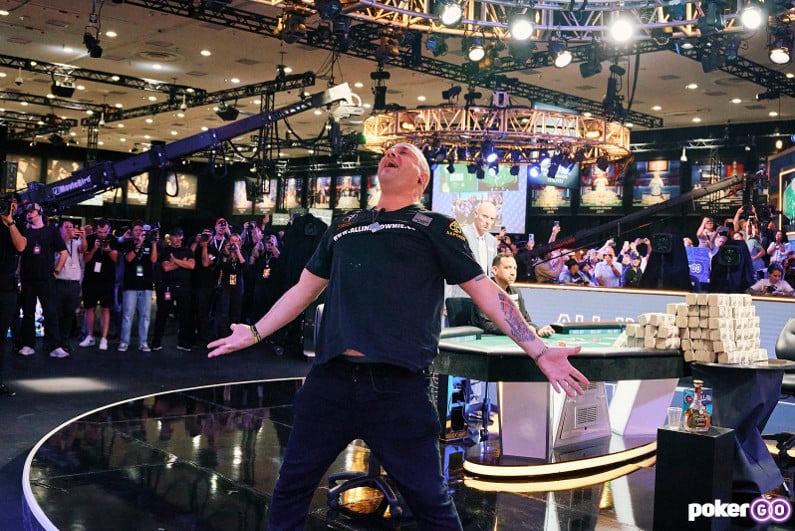Strategic adjustments
Our book Poker Satellite Strategy came out in 2019 and literally on the day we released it, legendary Tournament Director Matt Savage told us about a new format of satellite that could, in theory, render the book obsolete.
We were skeptical about Target Stack, Cashout, or Milestone Satellites and didn’t think they would last as a format. In actual fact, the reality has landed somewhere between our own and Savage’s expectations. Milestone Satellites have become a permanent fixture in live poker, especially on the World Poker Tour and in PokerStars Live events, but they are yet to penetrate online poker.
understanding the ICM of regular satellites gives you 90% of what you need to play Milestone Satellites
Since the book came out, we regularly get asked about Milestone Satellites and in particular if the advice in Poker Satellite Strategy is useless for them. The short answer is no, contrary to what most people assume, understanding the ICM of regular satellites gives you 90% of what you need to play Milestone Satellites. The adjustments are minor but very counterintuitive, so we have updated Poker Satellite Strategy with our take on Milestone Satellites.
What are Milestone Satellites?
In a traditional satellite, seats are awarded to anyone who makes the money. If 100 players enter, the starting stacks are 10,000 and there are 10 seats, the final 10 players win a seat, regardless of their stack size. If you beat the bubble with 300,000 chips or 3,000 chips, you get the same prize.
A Milestone Satellite awards a seat to players who reach a certain chip stack size. If 100 players enter, the starting stacks are 10,000 and there are 10 seats, each player who gets to 100,000 chips wins a seat, regardless of when they get to 100,000 chips. If you get to 100,000 chips in the first blind level, you win the seat and you, and your chips, are taken out of play.
Milestone Satellites are still an evolving format, but there are two variants that appear to be the most popular, which we shall call the American Format and the PokerStars Format. The way in which they differ is largely around what happens when somebody gets their stack above the target.
In our example above, the aim is to get to 100,000 chips, but rarely will a player get to exactly 100,000 chips. A player with 50,000 chips might shove, get called, and win a pot of 130,000, for example, when you factor in blinds, antes, and any other dead money.
When a player reaches the milestone, they and their chips are taken out of play. So in this example what happens to those extra 30,000 chips?
In the American Format, which you see mostly Stateside and in events like the World Poker Tour, the additional 30,000 chips are removed from play too. This means that the milestone becomes lower for every other remaining seat. If there were one million chips in play and nine seats remaining, after those 130,000 chips are removed from play, the new target would be around 97,000. The later the tournament gets, the milestone gets much much lower.
the big difference is the surplus chips get redistributed to everyone left at the table
In the PokerStars Format, which you see mainly in Europe in events like the EPT, the big difference is the surplus chips get redistributed to everyone left at the table. If Player 1 wins 130,000 at an eight-handed table, 100,000 chips and that player are removed from play, and the extra 30,000 chips get divided equally amongst the remaining players, so they all get around 4,300 each. If Player 1 busts Player 2 when they earn those 130,000 chips, Player 2 does not get the lifeline of 4,300 chips. Instead, the 30,000 is shared among six players instead of seven, meaning they each get 5,000 chips.
This may seem like a small difference between the two formats, but it is a significant one.
In the American Format there is an incentive to stall if you have a big stack, because you may already be at a future milestone amount if another player gets to their target.
In the PokerStars Format it is more profitable to be at a table with big stacks because when they inevitably win their seat, you will get a bonus.
Are Milestone Satellites better?
Milestone Satellites were created to combat stalling in satellites. There is no reason to hang on, the logic goes, because you need to accumulate chips. One of the big benefits is that you can win your seat very quickly, almost always somebody wins a seat in the first hour.
There is also less incentive to steal chips, which is a common issue in live poker satellites. In any live poker satellite when the event is over, the organizers collect the chips and discover there are less than when they started. Because you don’t need all your chips to win a seat, some players pocket some of theirs to use in a future tournament or give to a friend also in the satellite. This problem is solved in Milestone Satellites because you need to accumulate a certain amount and pocketing your chips is counterproductive.
A player with 95% of the target does not want to lose any chips and can collude with a shorter player
While chip stealing is not encouraged, this does not make Milestone Satellites immune to cheating. There is a collusion risk in Milestone Satellites just as there is in regular satellites. In regular satellites players can collude when a big stack with a seat locked up bet/folds to a short stack, helping them survive at little cost to themselves. In Milestone Satellites the collusion risk flips around. A player with 95% of the target does not want to lose any chips and can collude with a shorter player to get them to chip dump the extra 5% they need to get over the line.
A big negative of Milestone Satellites is that they favor superior players and can be off-putting to amateur players. They favor a more aggressive chip accumulation strategy, which on the surface sounds like a good thing, but in our opinion betrays one of the big promises of satellites. A satellite should always be about getting weaker, amateur, players into big ‘bucket list’ type events. While the slow, stalling, chip preservation strategy that is required in satellites may seem against the spirit of the game, it is one that a relatively new player can adopt successfully. Our question to you if you don’t like regular satellites is, don’t you want weaker players in the target events? Stalling seems like a bug in satellites, but we would say they are a feature.
The jury is also out on whether Milestone Satellites prevent stalling anyway, within the book, we will identify situations where stalling is the optimal strategy. At the time of writing, there is less stalling in Milestone Satellites if for no other reason than most players don’t realize the situations when it is to their advantage to stall.
Are Milestone Satellites better than regular satellites? Our answer is they are just a format like any other and in particular, we always welcome a new format that the solvers have not caught up to yet. At the time of writing, there are no commercially available solvers for the format. However, for the overall health of the poker ecosystem, we would hate to see regular satellites die out because we strongly believe they allow more amateur players to play in large events. A large part of the reason we held back until now about adding them to the book is we believe most recreational players prefer the traditional format, but now that the format is clearly here to stay the best way to decrease the knowledge deficit between recreational and pros is to educate recreationals on the optimal strategy so they won’t feel as reluctant to play them.
An updated version
There are specific strategic adjustments you have to make in milestone satellites, so Barry Carter and I have finished a new chapter for Poker Satellite Strategy on the format.
The updated book will be out soon. When it is, people who already own a Kindle version will get the new chapter automatically. Obviously, that isn’t possible with printed versions bought before the update, so we wanted to give owners of Poker Satellite Strategy the chance to read the chapter for less than the price of a coffee, rather than buy the book again to see it. You can do so here:
.com: https://amazon.com/dp/B0CNKQ8ZVK
UK: https://amazon.co.uk/dp/B0CNKQ8ZVK
Don’t buy the ebook unless you have read Poker Satellite Strategy OR you understand satellites quite well. Better to wait for the updated whole book if not.
Also, Barry’s ego is so bloated after his recent 14th place finish in the International Poker Open that he’s now insisting on being the big name on the cover. But we won’t talk about that.




